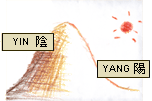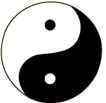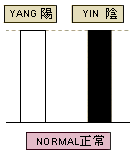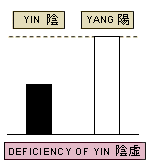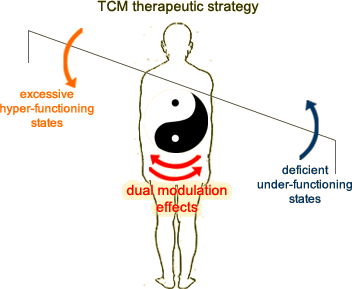Ancient Chinese people were greatly interested in the relationships and patterns that occurred in nature. Instead of studying isolated things, they viewed the world as a harmonious and holistic entity. In their eyes, no single being or form could exist unless it was seen in relation to its surrounding environment. By simplifying these relationships, they tried to explain complicated phenomena in the universe.
What is the Yin Yang Theory?
Yin yang theory is a kind of logic, which views things in relation to its whole. The theory is based on two basic components: yin and yang, which are neither materials nor energy. They combine in a complementary manner and form a method for explaining relationships between objects. Gradually, this logic was developed into a system of thought that was applied to other areas. Traditional Chinese Medicine (TCM) is an example of one area where the yin yang theory is used to understand complicated relationships in the body.
The Origin of the Yin Yang Theory
The original concept of yin and yang came from the observation of nature and the environment. “Yin” originally referred to the shady side of a slope while “yang” referred to the sunny side. Later, this thinking was used in understanding other things, which occurred in pairs and had complementary and opposing characteristics in nature. Some examples include: sky and earth, day and night, water and fire, active and passive, male and female and so on. Working with these ideas, ancient people recognized nearly all things could have yin and yang properties. Yin and yang can describe two relative aspects of the same phenomena such as the example of the slope, or they can describe two different objects like sky and earth.
Usually, yang is associated with functional aspect of an object and has more energetic qualities, for example, moving, ascending, expanding, heat, bright, progressing, active and hyper-functioning states. Yin, on the other hand, is associated with the physical form of an object and has less energetic qualities such as stillness, descending, contracting, cold, dark, degenerating, latent and under-functioning states.
| Frame of References | Yang | Yin |
| Light | Bright | Dark |
| Temperature | Hot | Cold |
| Position | Upper | Lower |
| Action | Movement | Rest |
| Direction | Outward | Inward |
| Physiological functions | Excitatory | Inhibitory |
By describing how things work in relation to the universe and to each other, the yin yang theory establishes a dynamic thought process that can be applied to everyday life.
Yin and Yang oppose each other.
 Yin yang theory believes everything has its dual aspect, the yin and the yang. The two aspects interact and control each other to keep in a continuous state of dynamic balance. For example, heat can dispel cold, while cold can reduce heat. If there is not enough heat, it will become cold and vice versa. Another example is the physiological functions in our body. Both the excitatory (yang) and the inhibitory (yin) functions are in mutually controlled balance. If the dynamic balance is disturbed, that one aspect becomes excessive, health problems will occur.
Yin yang theory believes everything has its dual aspect, the yin and the yang. The two aspects interact and control each other to keep in a continuous state of dynamic balance. For example, heat can dispel cold, while cold can reduce heat. If there is not enough heat, it will become cold and vice versa. Another example is the physiological functions in our body. Both the excitatory (yang) and the inhibitory (yin) functions are in mutually controlled balance. If the dynamic balance is disturbed, that one aspect becomes excessive, health problems will occur.
This process of mutual interaction and restriction is the operation of everything in the world.
Yin and Yang mutually create and depend on each other.
Yin and yang are bound together to form a whole, they cannot exist without each other or stand alone. They depend on each other for definition and can only be measured by comparing themselves to each other. For example, heat ceases to exist (yang aspect) if there is no such thing as cold (yin aspect). Without an understanding of hot and cold, there would only be one temperature. Height (yang aspect) cannot be measured if there is not a low reference point (yin aspect); otherwise, everything would be at one level. In addition, the comparisons between yin and yang are relative to the objects being compared. For example, water belongs to yang in relation to ice which is yin, however, water is considered to be yin in relation to steam which is more yang. Daytime belongs to yang in relation to the night which is yin, however, afternoon is considered to be yin in comparison to morning which is more yang.
According to the yin yang theory, life activities are the result of interaction between our physical body and its physiological functions. The activity (yang) of our body is nourished by its physical form (yin), and the physical form is created and maintained by the body’s activity. The two aspects rely on each other to achieve a balanced state of health.
Yin and Yang change and grow in a cyclic and balanced manner.
Yin and yang achieve a state of balance by mutual interaction and restriction. The balance is neither static nor absolute, but is maintained within certain limits. At certain times, yin expands while yang diminishes. At other times, the opposite is true. The change of seasons illustrates this concept. From winter through spring and summer, the weather changes from cold to hot. This is a process where yang (heat) grows and yin (cold) diminishes. On the other hand, the weather will change from hot to cold from summer through autumn and winter, a process where yin expands and yang diminishes. Over time, the proportion of hot (yang) and cold (yin) weather will be balanced and in harmony.
Yin and Yang transform into each other.
When one aspect goes to an extreme, it will undergo a reverse transformation into the opposite character. This sudden transformation usually takes place in a particular situation. For example, when summer reaches the hottest day (extreme yang), the weather begins changing in a reverse manner. Instead of becoming hotter, it starts to become cooler. When winter reaches its coldest day (extreme yin), the weather reverses its direction and becomes warmer. This transformation is the source of all changes, which allow both yin and yang to create each other. In the body, the pattern of yin yang transformation happens when excitatory and inhibitory functions transform into one another.
Yin and yang represent two opposite yet complementary aspects of objects, in which they interact with each other to maintain a dynamic balance. The ancient Chinese used the interrelationship between yin and yang to explain the phenomena in the body as well as the natural world. In traditional Chinese medicine (TCM), yin yang theory forms a foundation of TCM holistic healing, physicians use it to explain the body’s structure, physiological functions, pathological changes, and also guide clinical diagnosis and treatment.
Yin Yang Application in Human Body Structures
TCM views the human body as an organic unity. The sense of unity is based on the opposing yet complementary manner like yin and yang. The body’s organs and tissues are classified into yin and yang aspects based on their functions or locations, so that physicians can gain a closer look at the connections or interactions between different components of the body. For example, upper body versus lower body, body surface versus inter body, artery versus vein, structure versus function, absorption versus excretion, expiration versus inspiration, relaxation versus contraction, sensory system versus motor system and so on. The paired aspects are mutually controlled and interacted with each other, if one is dominant over the other part, trouble will arise.
Yin Yang Application in Physiological Functions
Traditional Chinese medicine (TCM) stresses that humans are a part of nature, and are subject to natural law of balance and harmony. Life activities are resulted from interactions of the body components that work in a harmonious and unified manner. Yin yang theory is used as the basis model to understand how the body attains its harmonious balance physiologically.
As already mentioned, the body’s physical forms pertain to yin, while the body’s activities or functions pertain to yang. Life is sustained when the body’s physical forms and its functions are dynamically balanced; the two aspects mutually restrict and depend on one another. As TCM classics state: “yin essence (nutrient materials) is the material basis for the transformation of yang qi (physiological functions), while the actions of yang qi lead to constant production of yin essence. Yin essence and yang qi mutually transform and consume one another.” For the internal organs, consumption of fundamental substances (relatively yang process) ensure them to function, while the organ functions promote material metabolism and in turn produce the fundamental substances for the body (relatively yin process).
According to TCM theory, the four directions of qi movement, including upward, downward, outward and inward, are the basic forms of life activities. The different movements of qi work in a coordinated manner; the ascending balances the descending movement, the outward balances the inward movement. Qi balance is important for promoting the physiological functions of different tissues, organs and meridians.
Inside the body, blood and qi can also pertain to yin and yang respectively. Qi creates blood and promotes its circulation, on the other hand, blood carries and nourishes qi; their relationship is just like the mutual dependent relationship of yin and yang. The internal organs are grouped according to their yin and yang characters. The five yin organs (heart, liver, spleen, lungs and kidneys) are solid organs and mainly responsible for the storage of essence and qi (relatively yin function); while the six yang organs (gallbladder, stomach, large intestine, small intestine, bladder and triple burners) are hollow organs and mainly responsible for digestion, transmission and excretion of the body (relatively yang functions). Normal physiological functions are based on interdependent and interactive relationships between the yin and yang organs.
Traditionally, physicians apply the yin yang concept to represent certain organ properties or describe particular functions of the body.
|
||||||||||||||||||||||
Yin Yang Application in TCM Pathological Changes
Traditional Chinese medicine (TCM) believes that health is achieved when the body is in a dynamic balance, meaning that all the body components, including the internal and external body, the upper and lower body, functions and structures, even in between the functional activities or essential substances, are maintain in an integral harmony. Disharmony is the root cause of diseases and physiological disorders. Yin yang theory is used as a way of comparative analysis of body imbalance, and disharmony is referred as the proportions of body’s yin and yang are out of their normal limits, becoming unequal and uncoordinated. For example, when one aspect becomes deficient, the other will be in excess, the balance is then disturbed.
From a holistic viewpoint, two aspects must be considered when evaluating disease development: pathogens (TCM term evils) and the body’s resistance (TCM term healthy energy). The conflict between the two forces is what allows the disease to either progress or recover to a healthy state. When an individual is strong, and the body functions well and has good immunity, it is easier to recover from a disease.
There are many factors that cause the body to become unbalanced, but they are all related to the conflict between healthy energy and pathogens. Physicians apply the yin yang theory to gain a general picture of disease development and how it runs its course.
The body’s resources and abilities to resist can be divided into the material aspect (TCM term yin essence) and the functional aspect (TCM term yang qi). While pathogens include yin and yang evils, for example cold and dampness belong to yin evils; wind, summer heat, and fire belong to yang evils. Yang evils tend to damage yin essence, while yin evils tend to damage yang qi.
Basically, a disease can be interpreted as the result of conflict between the yin and yang forces:
Yin Yang Application in TCM Diagnosis
According to the concept of organic wholeness, health is achieved when we maintain an integral harmony within the body, and also with the external environment. Disharmony or imbalance is the root cause of diseases and physiological disorders, which mean the proportions of body’s yin and yang are out of their normal limits, becoming unequal and uncoordinated. For example, when one aspect becomes deficient, the other will be in excess, the balance is then disturbed and health problems occur. Yin yang theory is used as the basic guideline of diagnosis in tradition Chinese medicine (TCM).
TCM physicians rely on the Four Examination Skills to gather clinical information, while identifying symptoms and signs according to yin and yang is the first priority, which helps physicians reduce the source of disharmony in the body. Generally speaking, yang signs are associated with excitatory, hyperactive, hot, progressing externally, developing upward and improving manifestations. Yin signs, on the other hand, are associated with inhibitory, hidden, passive, cold, progressing internally and developing downward and worsening manifestations. Below are some yin and yang manifestations that gathered by the Four Examination Skills.
| Yin manifestations | Yang manifestations | |
| Inspection | Apathetic, silent, mental fatigue, lusterless and dull complexion, a pale tongue that looks tender and bulky | Agitated, restless, irritability, lustrous and glowing complexion, a red tongue with yellow coating |
| Listening and smelling | A feeble voice, weak and shallow breathing, watery and thin secretions | A loud voice, coarse and fast breathing, thick and sticky secretions |
| Inquiring | Chills, no appetite, prefer hot drinks when thirsty, fatigue, general weakness, loose bowels, plentiful and clear urine, sleepiness, dull pain or soreness, and slow and chronic disease course | Fever, prefer cold drinks when thirsty, mouth dryness, dry and hard stools, scanty and yellowish urine, burning or stabbing pain or colic, acute disease, and rapid onset |
| Palpation | Pulse is deep, fine, hesitant or slow | Pulse is floating, surging, rolling or rapid |
Syndrome differentiation (identifying disharmony pattern) is the method of recognizing and diagnosing diseases or body imbalances in TCM. For preliminarily evaluation, the collected symptoms and signs are categorized according to a system known as the “eight principles”, which contain four pattern pairs: interior and exterior, cold and heat, deficiency and excess, and yin and yang. Among the eight patterns, yin and yang patterns are the most fundamental and essential. Physicians will first identify whether the disharmony pattern is ascribed to yin or ascribed to yang, because although the pattern may be complex with many changes, it still does not depart from the two major categories.
Importance of the “eight principles” in TCM diagnosis
| Yang | Yin | To determine the relationship between pathogens and healthy energy within the body |
| Exterior | Interior | To determine the diseased region |
| Excess | Deficiency | To determine the strength or weakness of the body |
| Heat | Cold | To determine the nature of the disease |
Yin Yang Application in TCM Treatment
In traditional Chinese medicine (TCM), patients are treated as a whole; physicians always take care of the whole body rather than local pathology. On the one hand, physicians eliminate the pathogenic factors to relive symptoms, on the other hand, they regulate the physiological functions to enhance the innate healing ability of the body and ensure a full recovery. The two aspects which are known as “dispelling pathogens” and “supporting healthy energy” respectively, are the primary therapeutic principles of TCM. For this reason, TCM treatment is unlikely to interfere with the normal functions of the body, one of the most important features of TCM.
Yin yang theory forms a basic guideline of TCM holistic approach. Since disease is regarded as the conflict between pathogens and healthy energy within the body, individual can recover more easily when direction of this conflict is towards a positive side. It is the universal treatment goal to correct imbalance and resume harmony of the body.
TCM therapeutic strategy is to readjust the body’s yin and yang aspects into a new balance state. When one aspect is excessive, the treatment aims at reducing the excess. On the other hand, when one aspect is deficient, the treatment is to tonify the deficiency. If excess and deficiency take place simultaneously, both reducing the excess and tonifying the deficiency are necessary. In other words, physicians try to shift the body into a new balance state by applying measures that are opposite of the condition. Below are some essential aspects of treatment:
- When a deficiency exists, it should be toned up;
- When an excess exists, it should be reduced;
- When too much heat is present, it should be cooled;
- When too much cold is present, it should be warmed;
- When dampness is present, it should be dried;
- When phlegm is present, it should be resolved.
1. Excess of Yang
This morbid condition is usually induced by an overabundance of pathogens that trigger a fierce struggle within the body. For example, individuals with pneumonia (an infection of the lungs) may have high fever, red face, coarse respiration and a rapid and surging pulse. The symptoms and signs show a relative excess of “heat” and belong to yang characters. Since the yin aspect is still normal, the “excessive heat” indicates the body is predominant in yang aspect (or excess of yang).
Physicians will conclude that the condition is due to invasion of external yang evils, which make the body create “excessive heat”. The treatment strategy then relies on cooling down or eliminating the “excessive heat” with “cold” herbs. (The word “cold” is used to describe the nature of certain herbs that have cooling properties.) Once the heat is removed, the body will be in balance again and health is restored. The “heat” that creates in yang excess conditions is named as excess heat.
2. Deficiency of Yin
This morbid condition usually indicates that the body lacks nourishment and lubrication, or declines in cooling, calming, holding and consolidating actions. Since yin and yang mutually restrict and consume one another; when one recedes, the other predominates. In case if the body’s yin aspect become deficient, the relative excess of yang aspect develops, leading to mild but very specific “heat” signs such as dry mouth, fever in the afternoon, red cheeks, night sweats, warm palms and soles. This type of heat is called “virtual heat” because it is caused by a yin deficiency and not “real” yang excess. A yin deficient disharmony is commonly experienced by individuals with diabetes, menopause, chronic low fever and tuberculosis. Unlike the condition of “excessive heat” described under yang excess, the “deficient or virtual heat” cannot be treated with “cold” herbs. Rather, the disharmony must be treated using yin nourishing herbs, so as to tonify the body’s yin aspect and reestablish a new balance state.
In TCM, yin deficiency often refers to a deficiency of yin fluids such as blood and body fluids. Without sufficient nourishment, excitatory functions become dominant leading to typical symptoms of hot flashes or night sweats. In general, virtual heat symptoms will automatically disappear when the deficient yin is tonfied, and the body resumes its balance.
3. Importance of treatment based on syndrome differentiation
Syndrome differentiation (identifying a disharmony pattern) is the premise and foundation of TCM treatment. Physicians must first group the seemingly unrelated clinical symptoms and signs into a particular diagnostic category, which then uses it to decide the treatment. The yin yang category is a compendium of all, which gives physicians a general picture of the patients’ disharmony. As the above two cases, both yin deficiency and yang excess have heat symptoms but there are differences in their manifestations. “Excess heat” can lead to a high fever while “virtual heat” may cause just a night fever or a low-grade fever. A person with “excess heat” has a pulse that is rapid and surging, while a person with “virtual heat” has a rapid and fine pulse. These subtle differences in clinical manifestations are what every physician tries to recognize during diagnosis.



